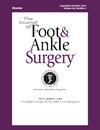Determination of pathogens in deep surgical site infections following sinus tarsi approach calcaneal fracture surgery via open reduction internal fixation or primary arthrodesis - Implications for prophylaxis and treatment
IF 1.3
4区 医学
Q2 Medicine
引用次数: 0
Abstract
High rates of surgical site infections (SSI) have been reported after calcaneal fracture surgery. The aims of the current study were to re-evaluate the rate of deep SSIs after ORIF of displaced intra-articular calcaneal fractures via the sinus tarsi approach, to identify different types of bacteria in the first obtained cultures and to determine the accuracy of the initially started (empiric) antibiotics prior to the results of the cultures. A search was performed from August 2012 to December 2023 using the specific surgical code for this procedure. Besides subject and surgery characteristics, the occurrence of deep SSI, the causative pathogens, and subsequent treatment strategies were documented. A total of 391 patients were screened for wound complications, among these patients fifteen deep SSI were found after a sinus tarsi approach (STA) (3.4%). The median age of patients was 57 (IQR 22) years, the majority of these patients identified as male (n=13, 87%) and were smokers (n=10, 67%). The most prevalent microorganisms were Staphylococcus aureus (present in 73.3% of cultures) and Enterobacter cloacae complex (present in 53.3% of cultures). Eight patients had infections with multiple species of microorganisms. Given the fact that an Staphylococcus aureus and/or Enterobacter cloacae complex were present in more than half of the cultures, we recommend targeting empiric antibiotic treatment at both gram-positive and gram-negative microorganisms once a deep SSI is suspected after calcaneal fracture surgery.
通过切开复位内固定或原发性关节融合术进行跗骨窦入路跟骨骨折手术后深部手术部位感染的病原体测定-预防和治疗的意义
跟骨骨折术后手术部位感染(SSI)发生率高。本研究的目的是重新评估经跗骨窦入路对移位的跟骨关节内骨折进行ORIF后深度ssi的发生率,在第一次获得的培养物中识别不同类型的细菌,并确定在培养结果之前最初开始(经验性)抗生素的准确性。从2012年8月到2023年12月,使用该手术的特定手术代码进行了搜索。除受试者和手术特点外,还记录了深部SSI的发生、致病病原体和随后的治疗策略。共有391例患者接受了伤口并发症筛查,其中15例患者在鼻窦入路(STA)后发现深SSI(3.4%)。患者的中位年龄为57岁(IQR 22)岁,其中大多数患者为男性(n= 13,87%)和吸烟者(n= 10,67%)。最常见的微生物是金黄色葡萄球菌(存在于73.3%的培养物中)和阴沟肠杆菌复群(存在于53.3%的培养物中)。8名患者感染了多种微生物。考虑到一半以上的培养物中存在金黄色葡萄球菌和/或阴沟肠杆菌复合物,我们建议一旦在跟骨骨折手术后怀疑发生深部SSI,就针对革兰氏阳性和革兰氏阴性微生物进行经经验抗生素治疗。
本文章由计算机程序翻译,如有差异,请以英文原文为准。
求助全文
约1分钟内获得全文
求助全文
来源期刊

Journal of Foot & Ankle Surgery
ORTHOPEDICS-SURGERY
CiteScore
2.30
自引率
7.70%
发文量
234
审稿时长
29.8 weeks
期刊介绍:
The Journal of Foot & Ankle Surgery is the leading source for original, clinically-focused articles on the surgical and medical management of the foot and ankle. Each bi-monthly, peer-reviewed issue addresses relevant topics to the profession, such as: adult reconstruction of the forefoot; adult reconstruction of the hindfoot and ankle; diabetes; medicine/rheumatology; pediatrics; research; sports medicine; trauma; and tumors.
 求助内容:
求助内容: 应助结果提醒方式:
应助结果提醒方式:


